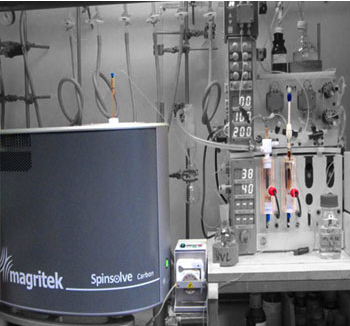Members Login

Channels
Special Offers & Promotions
The Ley Group at Cambridge Uses the Magritek Spinsolve Benchtop NMR System as an Integrated Part of their Flow Chemistry and Organic Synthesis Research

Magritek, a leading provider of compact NMR and MRI instruments, reports on the Laboratory of Professor Steven Ley in the Department of Chemistry at the University of Cambridge. Specialists in flow chemistry & organic synthesis, the lab is using the Spinsolve benchtop NMR integrated into their flow systems.
Professor Steven Ley's laboratories are located in the Department of Chemistry at the University of Cambridge. Their research specialises in flow chemistry and organic synthesis. They are renowned for collaborations with academic and industrial partners. Précising their work, Steve says “Complex synthesis remains a challenging occupation requiring an exceptional level of experimental skill, extensive knowledge of both mechanistic and molecular reactivity, and a bold, inventive, and creative spirit. It is the combination of these qualities that transforms the synthesis process from one of simple logistics to an art form.”
Dr Batool Omer worked in the Ley Group as a Postdoctoral Research Associate prior to taking up her current position at GSK. She has played a leading role in the integration of the Magritek Spinsolve into the flow research work carried out in Cambridge. She takes up the story, first outlining the main research interest. “The main interest of our research is to invent and develop novel synthetic methodologies with the focus on cutting-edge technologies in flow chemistry and intelligent synthetic platforms that complements not just industrial needs but also help to direct new chemical discoveries. In situ analytical tools play a crucial role in bringing together process control enabling prompt decision making when required, and, above all, they can capture a wealth of information that otherwise not accessible by off-line analysis. NMR is the most widely used analytical tool which enables both quantitative and qualitative analysis hence vital as a tool for gaining information on a chemical reactions and processes. In terms of teaching, NMR is one of the main analytical methods introduced early on in chemistry school and undergraduate programs to help young chemists to develop their ability to structure identification and quantification. For us, NMR is essential in both research and teaching.”
Dr Omer continues: “The main motivation is due to the inherent versatility of NMR spectroscopy which enables simultaneous structure identification and quantification.This feature makes it both a useful and indispensable tool in chemical synthesis. There are other complementary techniques including ReactIR. After evaluating a number of benchtop NMR systems, it is my opinion that the Magritek system gives the most potential. Simply it gives us the ability to integrate it into a flow process easily; it has the options of different flow cells; it has fast acquisition times and, most importantly, the sensitivity. I find the Spinsolve to be much more enhanced compared to others on the market. Furthermore, since I joined industry, I have noticed that a number of industries regard the Magritek system as a highly useful PAT (process analytical technology) tool.”
Magritek's Spinsolve benchtop NMR spectrometers are supplied worldwide to academics in teaching and research; also to industry for research and reaction monitoring through to quality control use.
Media Partners


